Key takeaways:
- Effective volunteer recruitment connects an organization’s mission with community values, fostering a united front for advocacy.
- Creating a welcoming environment, offering meaningful roles, and recognizing volunteer contributions significantly enhance engagement.
- Understanding target demographics and personalizing recruitment approaches can attract motivated individuals to the cause.
- Sharing personal stories and utilizing social media effectively can inspire others to join and strengthen the volunteer community.
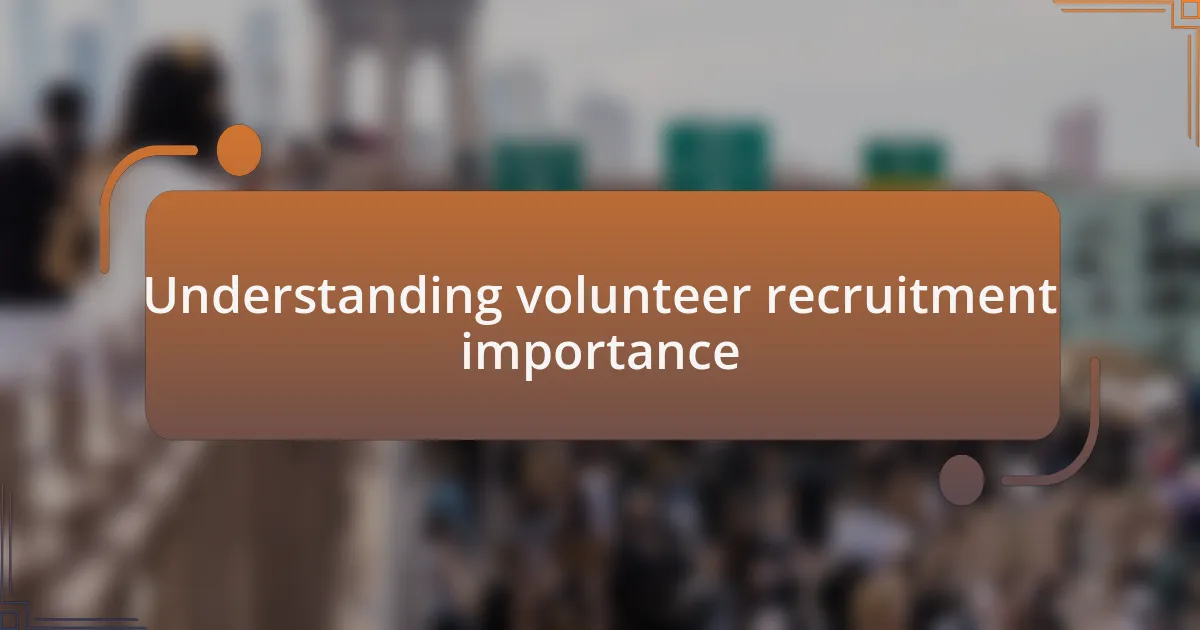
Understanding volunteer recruitment importance
Effective volunteer recruitment is crucial in any advocacy initiative, especially in pro-life work. I remember my early experiences, where each volunteer brought not just skills but also passion and fresh perspectives to our cause. Have you ever thought about how a single individual’s enthusiasm can change the entire dynamic of a group?
Moreover, the recruitment process serves as an essential bridge between an organization’s mission and the community’s values. I once engaged a volunteer who shared a deeply personal story about their own reproductive health journey, and it reinforced for all of us the profound impact that individual stories can have in rallying support. Isn’t it incredible how personal connections can galvanize a community towards a common goal?
Ultimately, successfully recruiting volunteers doesn’t just add numbers; it fosters a united front. I have seen the difference when passionate individuals come together, sharing their motivation and skills to advance our mission. What can be more powerful than a diverse group, driven by shared beliefs, working together for a cause they deeply care about?
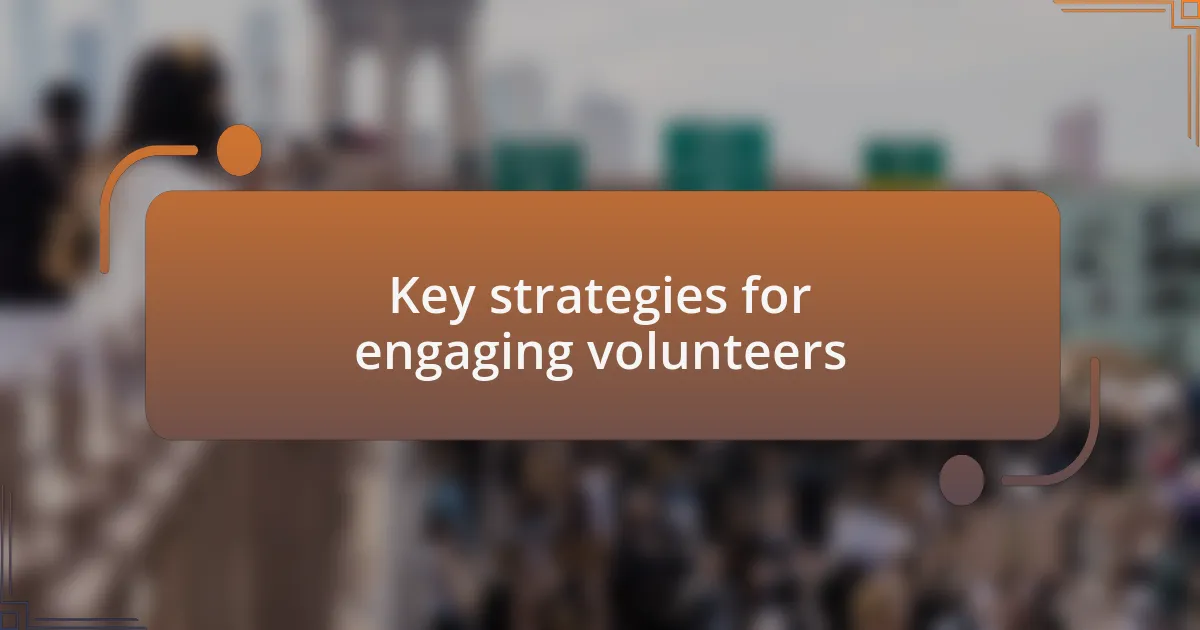
Key strategies for engaging volunteers
One of the most impactful strategies I’ve found for engaging volunteers is to create a welcoming environment that fosters connection. When I hosted a casual meet-and-greet event at my local community center, it was amazing to witness how quickly new volunteers bonded over shared interests and experiences. Have you ever noticed how simple conversations can ignite a sense of belonging and commitment?
Another effective approach is to offer meaningful roles that align with the interests and skills of the volunteers. I recall a graphic designer who joined our team and was thrilled to take charge of our social media campaigns. It was inspiring to see how her passion for design transformed our online presence, proving that when volunteers feel valued, they become more invested in the mission.
Lastly, recognizing and celebrating volunteer contributions can significantly boost engagement. One year, we organized an appreciation dinner where volunteers shared their successes and stories. The atmosphere was filled with gratitude, and it was moments like these that reminded me how important it is to acknowledge the hard work of those who stand alongside us. How do you celebrate your team’s efforts?
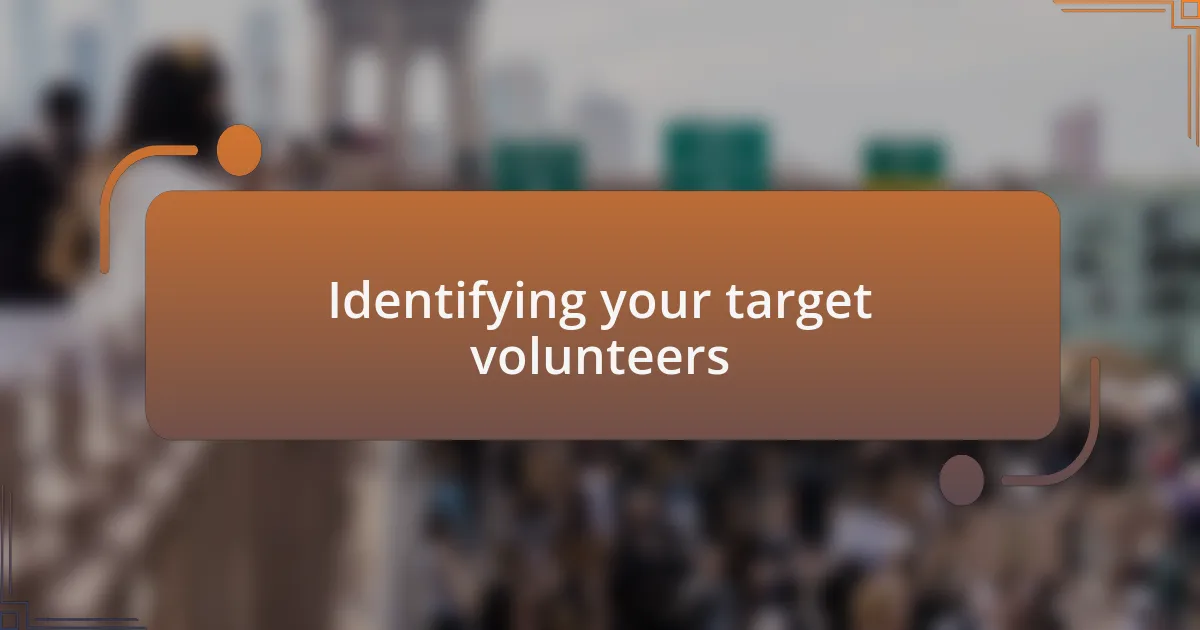
Identifying your target volunteers
Understanding who your target volunteers are is crucial for any successful recruitment strategy. In my experience, it’s important to consider demographics such as age, interests, and motivations. For instance, one time I engaged with a group of college students who were passionate about social issues. By tapping into their enthusiasm, we created initiatives that resonated with them, leading to an influx of lively new members.
I’ve found that segmenting potential volunteers based on specific areas of pro-life advocacy can help in crafting targeted messaging. When I tailored my outreach to families interested in pregnancy support, I witnessed a heartwarming response. Many were eager to share their own stories, and this connection sparked a genuine dialogue about how they could contribute.
It’s also beneficial to think about how your current volunteers can help identify new ones. I often ask my team for referrals; their firsthand experience makes them credible advocates. Have you considered that your current volunteers might know like-minded individuals who would jump at the chance to get involved? By leveraging these personal networks, you tap into a resource that can significantly enrich your volunteer pool.

Creating appealing volunteer opportunities
Creating appealing volunteer opportunities starts with offering experiences that resonate deeply with potential recruits. For me, nothing compares to the moment I organized a workshop series where volunteers got hands-on training in community advocacy. The excitement on their faces, as they honed skills to make a tangible impact, was truly inspiring. By creating opportunities that allow volunteers to learn and grow, you foster a sense of ownership that keeps them engaged.
It’s also essential to consider the flexibility and diversity of roles available. I remember when I developed various tasks, from event planning to social media outreach. This variety allowed individuals to choose roles that suited their skills and passions, which, in my experience, significantly boosted their commitment. Have you thought about how empowering your volunteers by letting them select their areas of involvement could lead to a more vibrant community?
Lastly, recognition plays a huge part in making these opportunities appealing. A simple acknowledgment can turn a fleeting commitment into a lasting relationship. I once initiated a volunteer appreciation night that not only celebrated individual contributions but also highlighted the collective achievements of our team. That event reinforced the notion that each volunteer’s work matters, transforming our group dynamics and strengthening our cause. Don’t underestimate the power of appreciation; it can truly elevate the volunteer experience.
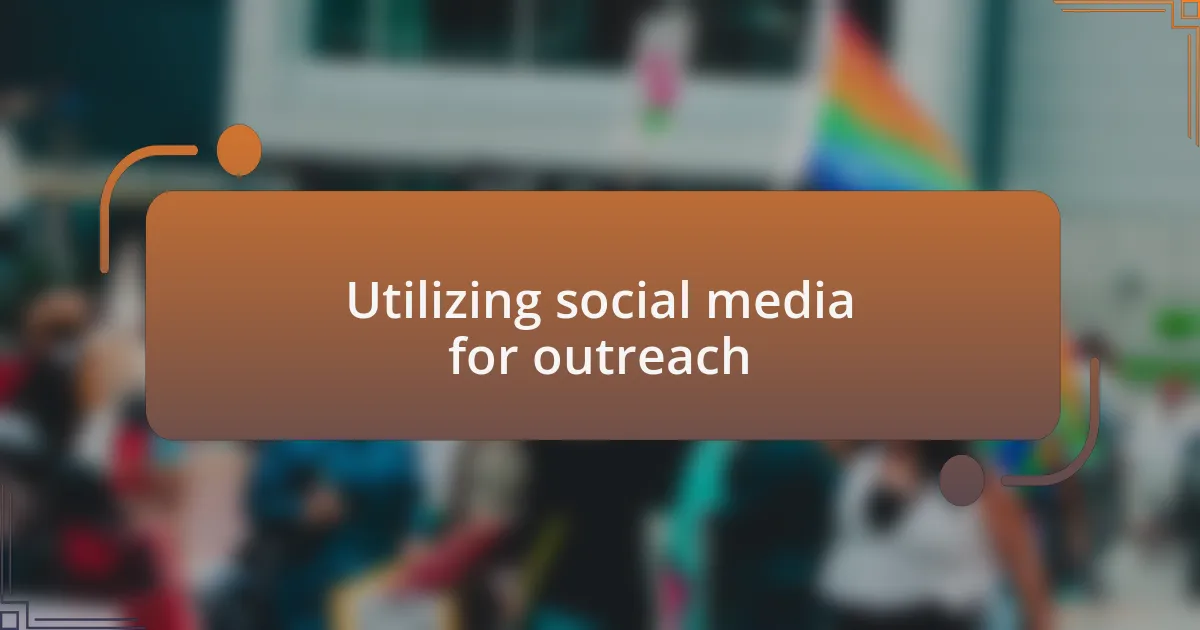
Utilizing social media for outreach
Utilizing social media for outreach is one of the most effective strategies I’ve discovered in my advocacy work. I vividly recall the time I crafted a simple Facebook post sharing a personal story about why pro-life advocacy is important to me. The response was overwhelming; not only did it spark conversations, but I also saw people step up to volunteer, eager to join the cause. Have you thought about how sharing your passion on social platforms can inspire others to take action?
Beyond just sharing stories, I found that engaging visuals are key in catching attention. Once, I posted a series of impactful images from a recent rally, along with quotes from participants. The result was astonishing—a wave of shares and comments flooded in, creating a buzz that brought in volunteers who felt connected to the movement. Visuals not only attract attention but create an emotional connection that text alone often struggles to deliver.
Additionally, leveraging local groups on platforms like Instagram or Twitter can target individuals who are already interested in advocacy. I remember joining a local pro-life group where I shared my experiences and actively responded to others’ posts. This kind of interaction nurtured relationships that led to several motivated volunteers reaching out to me for collaboration. It’s a friendly reminder that genuine connection, even in the digital space, can cultivate a strong community ready to advocate together.
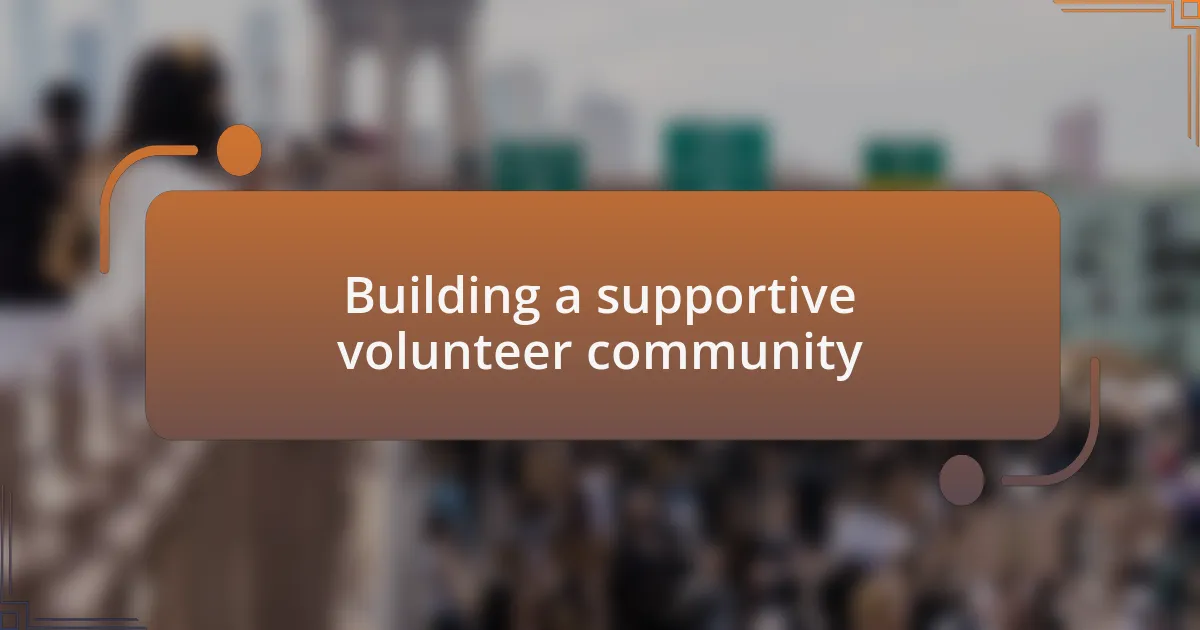
Building a supportive volunteer community
Creating a supportive volunteer community begins with fostering genuine relationships. I remember attending a local meet-up where I shared my experiences and actively listened to others’ stories. That simple act of openness transformed the group into a safe space, encouraging members to connect on a personal level. Have you ever noticed how sharing vulnerability can build stronger bonds?
In my experience, providing ongoing support and resources for volunteers is crucial. I once organized a workshop where seasoned volunteers shared their insights with newcomers. The encouragement and camaraderie blossomed during those sessions, creating an atmosphere where everyone felt valuable. This sense of belonging, I believe, ignites passion and commitment among volunteers.
Regular check-ins and appreciation can also make a significant difference in community building. I’ve found that sending a simple thank-you message or acknowledging someone’s contribution goes a long way. It nurtures a culture of appreciation and ensures that everyone knows their efforts matter. How often do you take the time to recognize those around you? It might just inspire them to stay engaged in the cause.
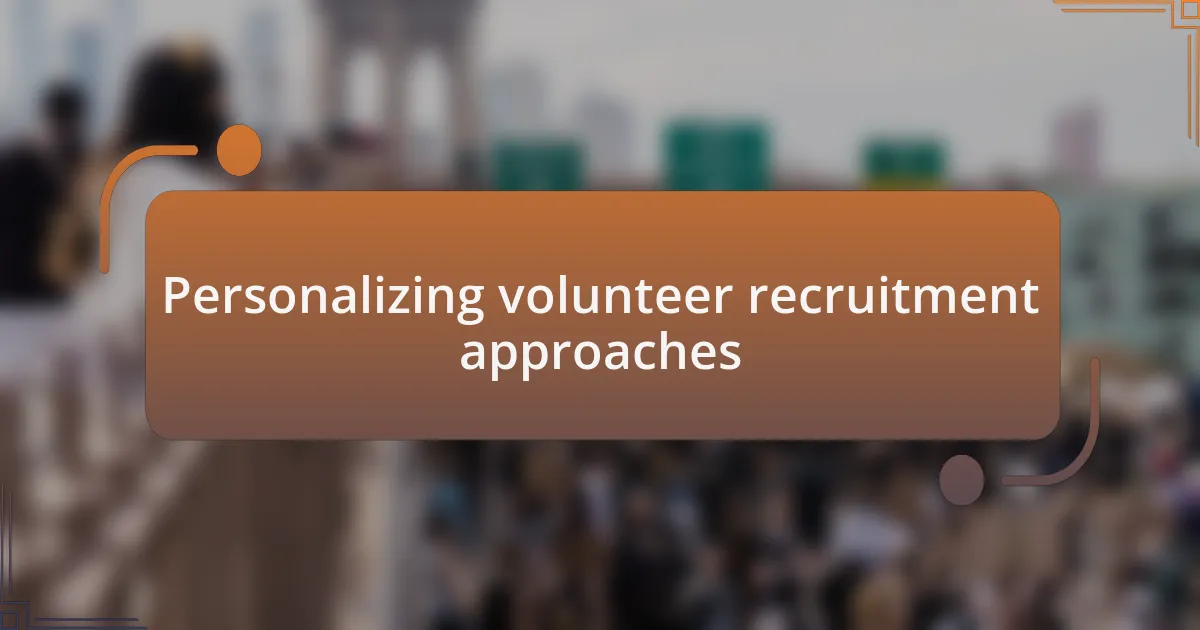
Personalizing volunteer recruitment approaches
Personalizing volunteer recruitment approaches starts with understanding the unique motivations of potential volunteers. When I first began recruiting for my projects, I made it a point to have one-on-one discussions with interested individuals. During these conversations, I learned about their personal stories and what drove them to support the pro-life movement. It’s eye-opening how tailored conversations can spark a deeper connection—have you ever thought about what truly inspires someone to get involved?
Another effective strategy I embraced was using targeted messaging that resonated with specific demographics. For instance, I organized an event focused on young parents, highlighting how their experiences could shape our advocacy efforts. Seeing the interest and excitement grow among that group was rewarding. It made me realize that when recruitment efforts speak directly to the audience’s lived experiences, they become more compelling. Have you considered how your messaging could better align with the interests of your potential volunteers?
Additionally, following up with personalized communication can reinforce initial interest and show that you genuinely value each person’s commitment. After a recruitment event, I made it a habit to send personalized emails thanking attendees and sharing how they could stay involved. This simple gesture not only maintained engagement but also made them feel recognized and appreciated. Have you ever noticed how a personal touch can transform a casual interest into a dedicated commitment?